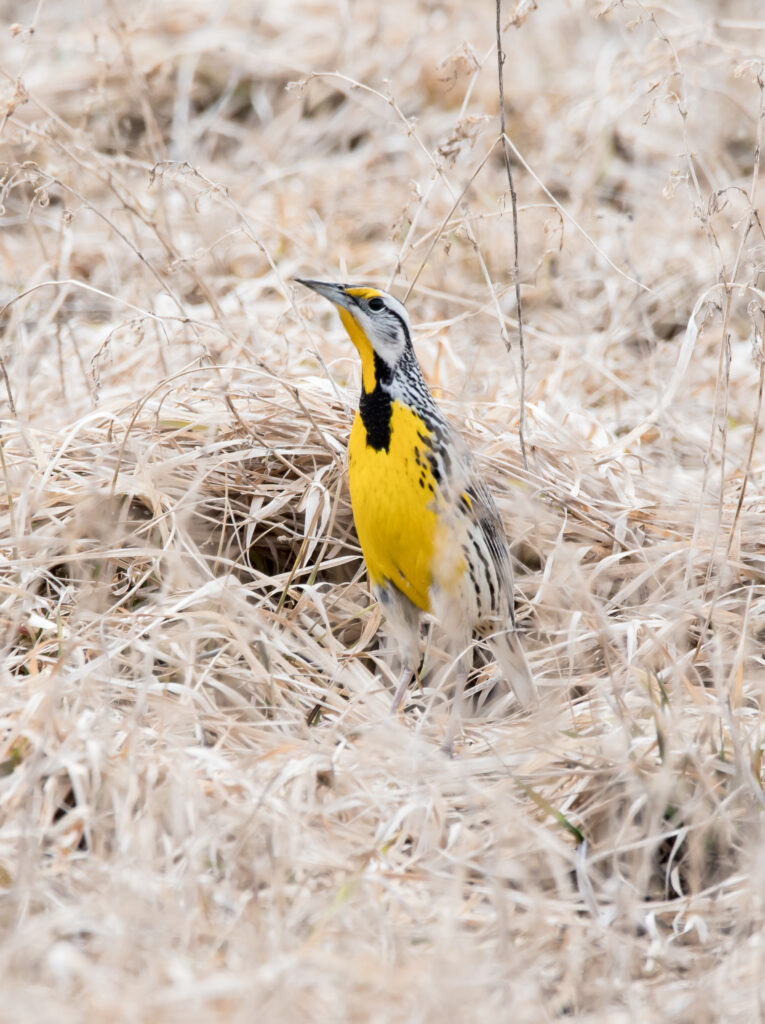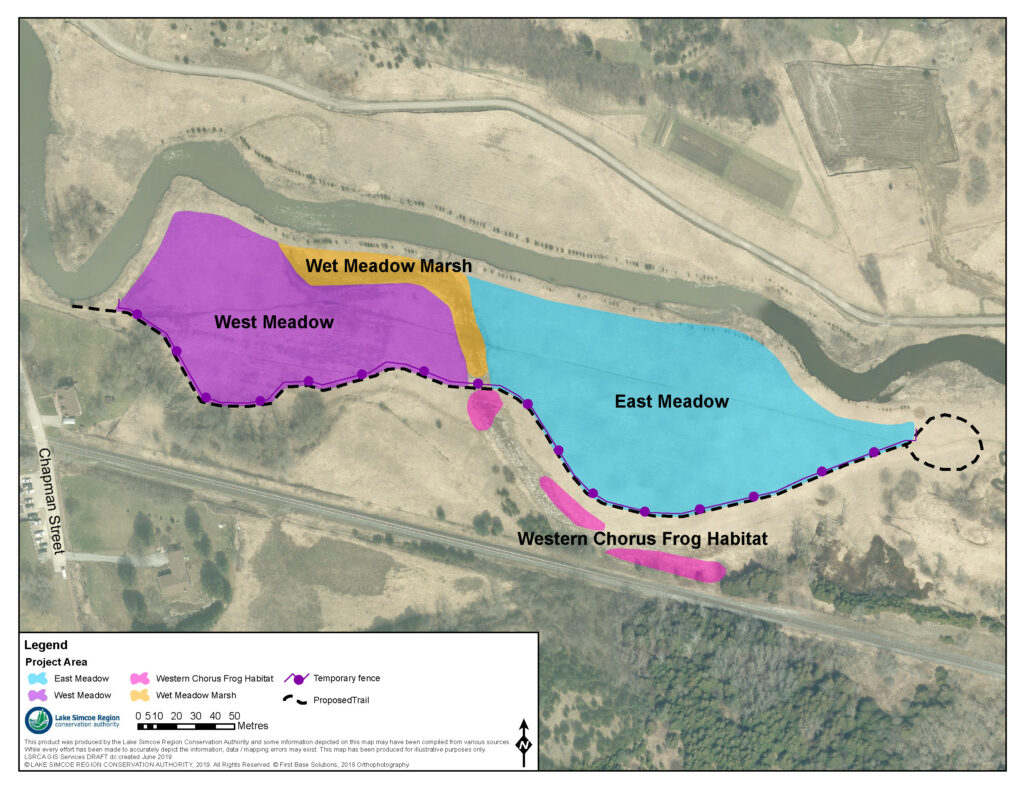Meadow Restoration
The (re)Making of a Marvelous Meadow
A unique new home for birds and butterflies coming soon to Rogers Reservoir
Restoring a former glory
It’s estimated that 99% of grasslands (including meadows) have been cleared from landscapes in southern Ontario. The four hectare patch we’re restoring at Rogers Reservoir will help increase this very threatened habitat. From grazing cattle to growing hay, the once rich-diversity of plant and animal species has suffered. The hardened compacted soil now only supports a few non-native and invasive plants.
Through the support of partners including the Town of East Gwillimbury and the Lake Simcoe Conservation Foundation, we’re excited to undertake a transformative restoration project at the south east corner of Mt. Albert and Yonge St.
Meadow Restoration at Rogers Reservoir
This native meadow will be a sight to behold – you’ll be able to see this beautiful landscape from the Nokiidaa Trail on the north side of the river, but a newly meandering trail will also allow you to explore up close. As we move forward with this project, there may be opportunities to participate in meetings, plantings, guided walks and more.
Make sure you join the Rogers Reservoir mailing list to stay informed of upcoming opportunities.
What are the next steps?
Restoring a native meadow can take a few years and during that time having fast growing non-native species throughout is common to see as it establishes. Our grassland contractor keeps a close eye on things and we’ve began to see some of the natives species flourish! This is a sign that they have begun to establish their roots and others will soon do the same!
Although some natives are thriving, we are still seeing some plant species we don’t want. And of course, we want to control them.
Protecting wildlife and the native grasses and wildflowers
We have used high mows to help reduce the non-native species in the meadow as they weaken the plants and don’t allow them to go to seed. This type of mowing does not negatively affect the native species that were planted since they are busy establishing their roots which can take several years. To ensure we have not disrupted any nesting birds during the process, a breeding bird survey is completed prior to any cutting.
Controlled burn completed in April 2023
What is a controlled burn? It is a deliberately set and carefully controlled low fire that consumes the previous year’s stems and leaves. These burns are an effective tool used to help manage grassland habitat. They can assist with the suppression of invasive species and further enhance the growing medium in the meadow by creating an ideal seedbed post-burn.
On April 12, 2023 we completed our first in-house burn at the meadow alongside our burn consultant and it was a great success! The burn was able to remove most of the previous year’s stems and all of the leaves at the site. The seedbed post burn is ideal for seeding which was also completed a week after the burn.
Will there be any more spraying or seeding?
In November of 2022, our grassland contractor seeded the meadow on top of the snow and then worked the seeds through the snow layer using drill coulters. This helps the seeds move down to the soil which is essential for seed growth. This was completed in the fall because it is a great time to seed as the cold winter temperatures actually assist with germination the following spring and stimulate plant growth. Seeding was done after the burn in 2023 and additional seeding may take place in the fall.
High mows and herbicide spot treatments may also be required in 2023 because burning alone does not eliminate non-native species and sometimes can make the situation worse if left unchecked. Our staff and contractor will be carefully monitoring post burn to ensure it’s success.
Tree Plantings along the trail
We’ve worked with volunteers to plant trees along the trail adjacent to the meadow. In the spring of 2022, we planted 170 native shrubs with volunteers from Neighbourhood Network and in the fall we planted an additional 100 native shrubs with volunteers from BCX Environmental Consulting.
We ask that visitors and their pets respect all posted signage, follow detour routes and stay out of areas under restoration.
Lorem ipsum dolor sit amet, consectetur adipiscing elit. Ut elit tellus, luctus nec ullamcorper mattis, pulvinar dapibus leo.
Four New Unique Habitats are Coming!
- The new 1 hectare The West Meadow area will feature beautiful native grasses and will be the perfect habitat for nesting birds, like the Eastern Meadowlark and Bobolink.
- The 2 hectare East Meadow section will be the largest of the four and will include picturesque pollinator-friendly plants such as Butterfly Milkweed and Wild Bergamot.
- A Wet Meadow Marsh 0.7 hectares in size will help retain water during wet spells and allow moisture-loving plants like Swamp Milkweed to thrive.
- The 0.15 hectare Western Chorus Frog Habitat will be made up of a seasonal body of water surrounded by native plants and shrubs to entice many types of frogs and other amphibians to take up residence.
What's a meadow? What does it do?
A meadow is a landscape consisting of grasses and wildflowers and not woody plants or trees. There are different kinds of grasslands each providing distinctive ecological roles and habitats for different animals. These grasslands include meadows, prairies, oak savannahs or even pastures and hay fields.
Meadows are vital to a healthy and resilient ecosystem for many reasons.
- They have a great ability to store a large amount of carbon and release it very slowly, mitigating the effects of climate change.
- The deep roots of meadow species help not only filter contaminants that accumulate in run off, they also absorb more water and therefore prevent flooding.
- Meadows provide excellent habitat for a number of birds who will not nest elsewhere and are therefore at-risk: the Eastern Meadowlark and the Bobolink.
- The numerous native flowering plants that make up a meadow benefit pollinators, like bees and butterflies, who are essential to produce the food we eat.

Perhaps most noticeable of all to us, a meadow is a sight to behold year around: from the long swaying grasses of Big Blue Stem and Indian Grass, and the colourful flowers and winged visitors of the spring, summer, and fall.
The abundance of types of plants is more than just beautiful; it helps encourage biodiversity as a whole. With the increasing urbanization and fragmentation of our watershed, conservation of our local grasslands is critical.
If you have questions or would like more information about this project, contact Lori McLean, Restoration Project Specialist at l.mclean@LSRCA.on.ca or 905-895-1281.
![]() We can help you get your OWN meadow!
We can help you get your OWN meadow!
Do you own two or more acres of land in the Lake Simcoe watershed? Build your own meadow, right on your own land! We can provide advice, expertise, and up to $10,000 in funding! There’s never been a better time to retire that hayfield or reduce your mowing.
![]() Stay tuned for more updates!
Stay tuned for more updates!
We will continue to share updates as we move forward with this project. Be sure to join our mailing list to receive the latest news.

